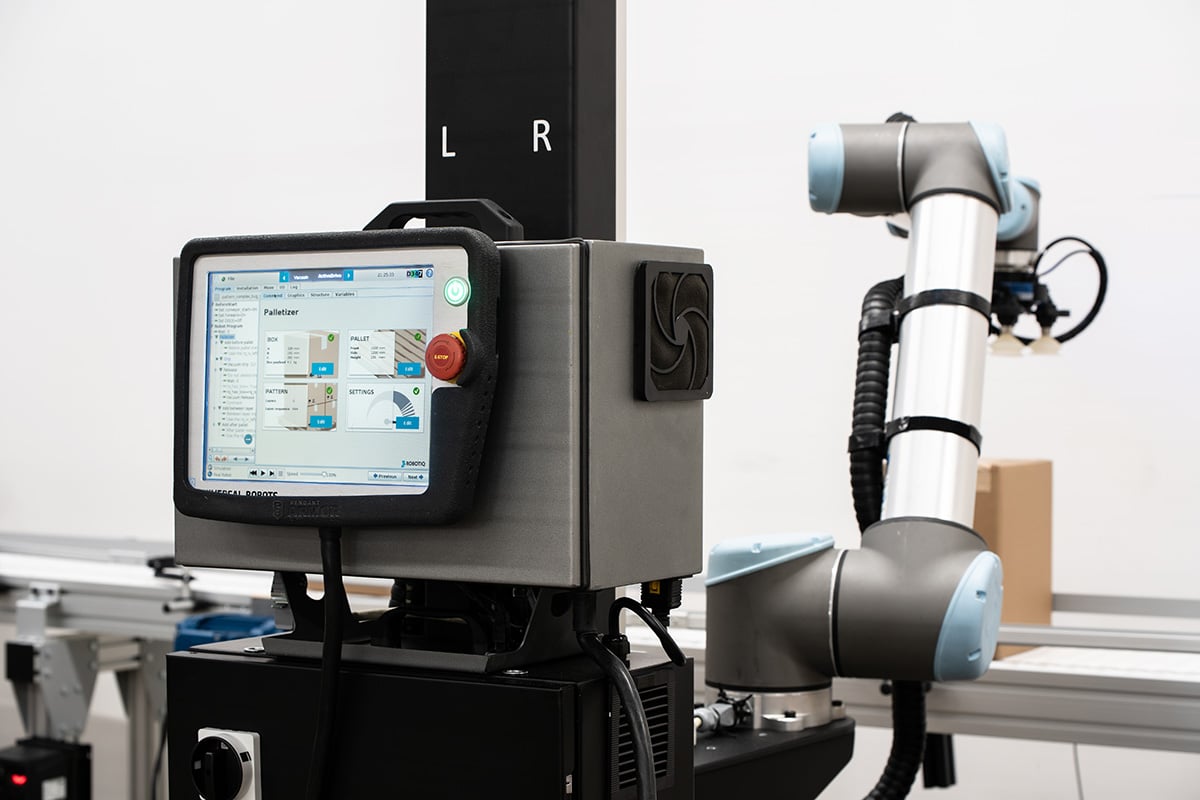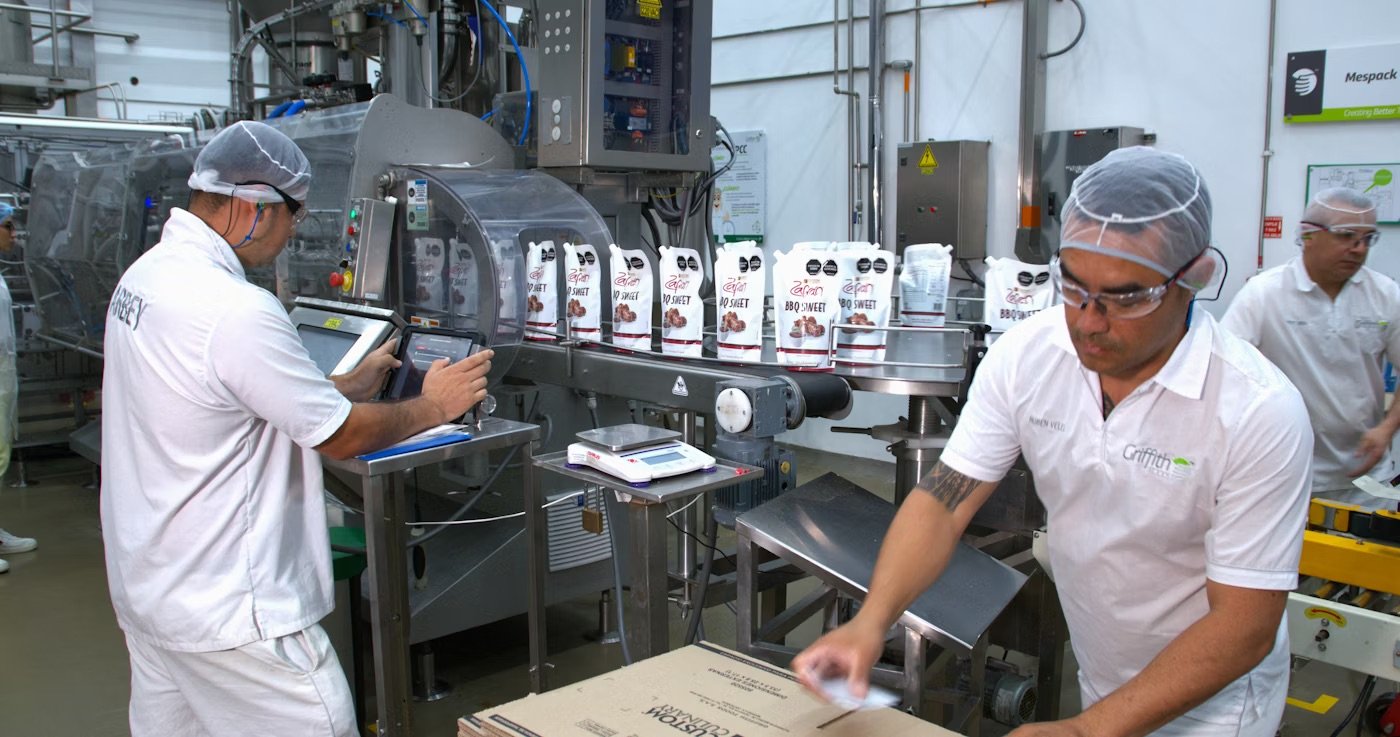Centralized vs Decentralized Palletizing: What's the Difference?

Posted on Feb 12, 2021 in Palletizing
5 min read time
You've got a final-stage packing task that you want to automate.
A robot seems like the best option, but you're not sure what approach you should use.
Should you go with centralized or decentralized palletizing?
What do these terms even mean?
Palletizing is a perfect task for a robot. It is boring, repetitive work and isn't a good use of a person's time. Robots are also more consistent than humans which can lead to better-packed pallets and more uniformity for your shipping team.
You might think that you just need to bring in a palletizing robot and it will solve everything. However, you will need to make a few more decisions upfront to ensure that your palletizing application is a success.
First, you'll need to decide what type of robot to choose: a large industrial robot or a more accessible collaborative robot.
Why "one big robot" is the default solution
A lot of people assume that there's only one approach to palletizing. They see YouTube videos of huge industrial palletizing robots working in factories and think that these are the only way to set up an automated palletizing operation.
In reality, there are more options for palletizing than you might first imagine. There are custom-designed palletizing machines that are only really suited to high-volume, inflexible production. There are dedicated palletizing robots with enough payload capacity to lift a small boat.
Then, there are collaborative robot palletizing solutions that can easily slot into many operations.
After you have decided on your type of robot, you need to decide the methodology for the palletizing: centralized or decentralized.
The videos of palletizing robots that you see online are often an example of centralized palletizing. Everything revolves around the robot and you have to adapt your existing processes so that they feed easily into the centralized robot. For years, this has been the main option for robotic palletizing because the alternative was cost-restrictive for most businesses.
Centralized palletizing applies to all types of palletizing robots. However, it's not the only option.
With the smaller collaborative robots, you also have the option of decentralized palletizing.

The 2 approaches to robotic palletizing
Palletizing is a tertiary packaging process that involves arranging products on a wooden pallet for shipment. The use of robotics in palletizing has become quite a competitive advantage for companies looking to streamline their packaging process.
There are two philosophies for robotic palletizing:
- You can have one robot that handles the palletizing for all of your different product lines simultaneously. This is common in high-volume production environments where large palletizing robots are used to quickly pack hundreds or thousands of products an hour. This is centralized palletizing.
- You can have multiple palletizing robots that each only handles one or a few product lines. This allows teams to be wholly responsible for their entire product line, including packaging. This is decentralized palletizing.
Traditionally, centralized palletizing has been the only real automation option for many businesses. Before the rise of robotic palletizing, it was the only feasible way to use conventional palletizing machines. Even since the birth of robotic palletizing, many companies could only afford one palletizing robot, both in terms of the investment and the space that they took up.
Decentralized palletizing has become more prevalent within the last decade thanks to the rise of smaller robots.
What is centralized palletizing?
The basic concept behind centralized palletizing is that all of your product lines are fed into a single palletizing cell.
There are certainly advantages to this approach. For one thing, you only need to have one palletizing robot. This is beneficial because conventional palletizing robots take up so much floor space. All lines feed into a single palletizing area which minimizes the space they use.
The major disadvantage of this approach is its inflexibility. All your product lines must be palletized in a similar way so it doesn't leave much room for variation between products. Also, if the robot stops operating, suddenly your entire packaging operation grinds to a halt.
When to use centralized palletizing
Whatever type of robot you are using, there are times when centralized palletizing will be the right option for you.
For example, you might use it when:
- You only want one palletizing robot.
- Your product lines are very similar and are all packaged in the same way.
- You don't mind many conveyors in your facility feeding into the robot cell.
What is decentralized palletizing?
The basic concept behind decentralized palletizing is that each product line has its own palletizing robot — or that a few similar product lines feed into the same robot.
The great advantage of this approach is its flexibility. Each product line can be packaged most efficiently for that product and it doesn't require you to use long conveyors to move product to the robot. Also, making changes to a single palletizing robot will only affect its associated product line.
The disadvantage of this approach is that it requires more than one palletizing robot. This is not a problem with collaborative robots as they are less costly than their conventional alternatives and take up much less space.
When to use decentralized palletizing
Decentralized palletizing is best suited to smaller robots thanks to their flexibility and size.
You might choose decentralized palletizing when:
- You want to use fewer conveyors and other extras.
- Your product lines are different and/or changeable.
- You want a finer level of control over the packaging.
Choosing the best option for your situation
How do you decide whether you need to go with centralized or decentralized palletizing?
If this is your first robot palletizing deployment, it makes sense to go with one smaller product line as a test.
At this stage, you would only have one product line and one robot, so it doesn't really matter what you call it. The question of centralized vs decentralized only comes into play when you have multiple lines with automated palletizing.
Once you are looking to apply palletizing to more of your product lines, your experiences with your first deployment will give you a better understanding of which approach will be best for you.
You can also talk to one of our integration engineers for advice. Go to our Palletizing Solution page for more details.
Which approach do you think will work best in your business? Centralized or decentralized palletizing? Tell us in the comments below or join the discussion on LinkedIn, Twitter, Facebook, or the DoF professional robotics community.


-2.jpg)





Leave a comment